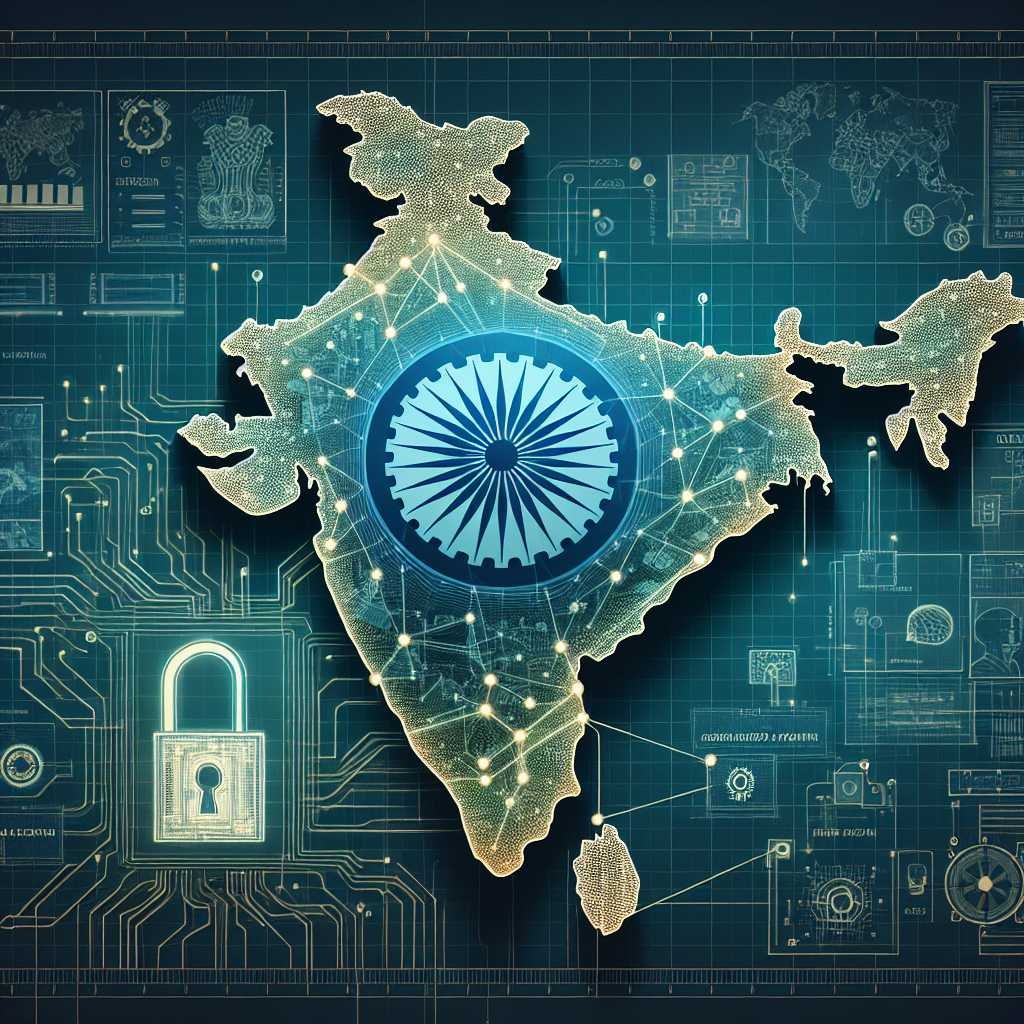The Future of AI Security in India: A Practical Cybersecurity Blueprint for 2030
Artificial Intelligence is no longer a lab experiment. It’s the backbone of digital public goods, national security, healthcare diagnostics, credit scoring, e-governance, and more. In India, where scale and speed collide—think Aadhaar, UPI, and expanding 5G—AI is fast becoming critical infrastructure. That makes AI security not just a technical checklist, but a strategic imperative tied to sovereignty, trust, and growth.
If you’re a practitioner, you want clear guidance on hardening data pipelines, models, and endpoints. If you’re a strategist, you’re balancing agility with compliance. If you’re a policymaker, you’re trying to set guardrails that protect citizens without stifling innovation. This blueprint is for all of you. It translates principles into playbooks, connects policy to operations, and keeps one idea front and center: AI security isn’t about locking down a tool—it’s about protecting human agency and India’s digital future.
Want to try it yourself? Shop on Amazon.
Why AI Security Is Now a National Priority
India’s digital economy is expanding at pace, and AI sits at the heart of that expansion. With large-scale datasets, cloud adoption, and citizen services integrating machine learning, India’s AI security posture affects everything from financial inclusion to disaster response. Here’s why this matters:
- AI systems now influence real decisions—loans, health triage, fraud detection, and border security.
- Data pipelines span multiple jurisdictions and vendors; supply chain weaknesses become national vulnerabilities.
- Bad actors have moved up the stack—from network exploits to model tampering and prompt attacks.
This is also a policy moment. India’s Digital Personal Data Protection Act (DPDP), cybersecurity controls by CERT-In, and critical infrastructure guidance from NCIIPC set a governance baseline. Aligning AI programs with these regimes—while keeping an eye on global frameworks like the NIST AI Risk Management Framework and ISO/IEC 23894—builds both compliance and confidence. For broader context, India’s AI policy and ecosystem updates are tracked on IndiaAI.
Here’s the takeaway: safeguarding AI is not optional. It’s a prerequisite for innovation at scale.
The 2025 AI Threat Landscape: What Teams in India Must Anticipate
AI systems fail in ways that traditional apps don’t. They’re probabilistic, data-dependent, and highly sensitive to small changes. That opens up new attack surfaces:
- Data poisoning and backdoors: Manipulating training data to bias or backdoor a model.
- Model theft and extraction: Copying a model’s behavior via API abuse.
- Prompt injection and jailbreaks: Tricking generative models to ignore safety policies.
- Supply chain compromise: Tampering with datasets, libraries, pre-trained weights, or MLOps pipelines.
- Adversarial examples: Tiny perturbations that cause misclassification in vision or audio systems.
- Privacy leakage: Models unintentionally revealing personal data memorized during training.
- Governance drift: Shadow AI, unmanaged endpoints, and undocumented datasets undermining compliance.
If you want a structured view of adversary behaviors, look at MITRE ATLAS. For application-layer risks, the OWASP Top 10 for LLM Applications is a practical checklist for developers and red teams.
Ready to upgrade your security stack? Check it on Amazon.
From Principles to Practice: An India-First AI Security Blueprint
Securing AI requires layered guardrails—policy, technical, and human. Think “defense in depth” adapted for machine learning.
Governance first: policy guardrails that scale
- Map obligations: Align your AI use cases with DPDP consent, purpose limitation, and data minimization principles (see MeitY for updates).
- Classify AI risk: Use risk-based tiers informed by international baselines (e.g., the EU’s AI Act approach) and tailor controls to high-impact systems (healthcare, finance, critical infra).
- Establish model accountability: For each model, designate an owner, document its purpose, data lineage, and evaluation results. Treat models like critical services with clear SLAs.
- Set escalation paths: Create policy-backed procedures for pausing or rolling back models when risk thresholds are breached.
Why it matters: Policy without process is theater. Formalizing responsibilities and thresholds reduces ambiguity when speed is critical.
Security-by-design for ML pipelines
Protect the pipeline end-to-end:
- Data layer: Enforce dataset provenance, hashing, and tamper-evident logs. Separate PII from feature stores; apply privacy-preserving techniques like differential privacy where appropriate.
- Training layer: Pin dependencies, scan containers, and isolate build environments. Validate pre-trained weights with checksums, and verify signatures when available.
- Model layer: Use watermarking or telemetry to monitor drift and potential theft. Maintain a model bill of materials (MBOM).
- Deployment layer: Enable inference-time input validation and output filtering. Rate-limit APIs, throttle unknown tokens, and block prompt-injection patterns.
- Runtime monitoring: Log prompts, responses, and model confidence (with strict PII handling) to support forensics and continuous improvement.
Compare options here: See price on Amazon.
Zero trust for AI systems
Traditional perimeter defenses won’t cut it. Apply zero-trust principles to AI:
- Least privilege for data and model access; rotate keys and secrets frequently.
- Strong identity for humans and services; enforce phishing-resistant MFA (security keys help).
- Micro-segmentation for MLOps components; isolate training from inference networks.
- Continuous verification: treat every inference as untrusted until validated by policy and context.
CISA’s Secure by Design guidance offers patterns that work well in AI-centric pipelines too.
Human-in-the-loop, by default
AI guardrails don’t eliminate human judgment; they elevate it. For high-stakes decisions, require human review and override. Provide operators with clear model cards, explanations, uncertainty metrics, and visibility into the data context. This balances speed with accountability, and it builds trust with regulators and users alike.
Operational Guardrails: Testing, Evaluation, and Red Teaming
Static “once-and-done” checks don’t work for models that evolve. Adopt continuous evaluation:
- Pre-deployment: Test models against curated adversarial datasets and known jailbreak prompts. Track performance, fairness, and safety metrics per use case.
- Red teaming: Maintain a living library of attack patterns (prompt injections, exfiltration prompts, adversarial examples). Rotate internal and external red teams to avoid blind spots.
- Safe output enforcement: Implement content filters, policy adapters, and retrieval constraints to prevent data leakage or unsafe responses.
- Post-deployment: Monitor telemetry for drift, anomaly responses, and unusual token patterns; set automated rollbacks on threshold breaches.
For teams building LLM features, consider a “sandboxed tool use” pattern: isolate function-calling capabilities, enforce strict schemas, and restrict access to sensitive connectors by default. Let me explain why that matters: one misconfigured connector can turn a helpful assistant into a data exfiltration engine.
Building Sovereign Resilience: Supply Chain, Compute, and Data
Resilience is about choice, assurance, and fallback plans:
- Supply chain assurance: Prefer vendors that publish software bills of materials and model provenance. Validate datasets and pre-trained weights with cryptographic attestations.
- Compute strategy: Mix domestic cloud regions with confidential computing for sensitive workloads. Favor providers that support hardware-based memory encryption.
- Data strategy: Localize sensitive data where possible; apply tokenization and synthetic data for model training to limit exposure.
- Exit plans: Maintain reproducible ML pipelines (infrastructure-as-code, model versioning) so you can migrate between providers under stress.
For high-value models, consider periodic offline re-training in a high-trust environment and controlled updates to reduce exposure to poisoned data streams.
How to Choose AI Security Tools and Platforms (Buying Guide)
The market is noisy. Here’s a simple way to evaluate tools without getting lost in jargon.
Start with your use case and risk tier. A chatbot for FAQs has different needs than a clinical decision support model. Map expected harms, regulatory requirements, and performance SLAs. Then evaluate vendors across five pillars:
1) Data protection and privacy
– Does the tool support fine-grained access controls, data masking, encryption at rest and in transit?
– Can it enforce DPDP-compliant consent and data minimization?
– Does it provide audit logs for dataset provenance and lineage?
2) Model and pipeline security
– Are there guardrails for prompt injection, prompt leakage, and jailbreaks?
– Does it integrate with CI/CD and MLOps for dependency scanning and container security?
– Can it produce an MBOM and cryptographic attestations?
3) Evaluation and monitoring
– Does it ship with adversarial test suites and bias/safety benchmarks?
– Can you define custom metrics and alerts for drift, toxicity, or privacy leakage?
– Is rollback automated on risk threshold breaches?
4) Governance and reporting
– Are model cards, risk assessments, and compliance dashboards built-in?
– Can it export evidence for auditors and regulators with minimal manual effort?
– Does it integrate with your GRC tooling?
5) Interoperability and cost
– Does it play well with your stack (cloud, identity, key management, data stores)?
– Is pricing aligned with your usage patterns (tokens, calls, seats)?
– Can you switch providers without rewriting everything?
Practical tip: run a 30-day proof of value with realistic traffic and red-team tests, and insist on shared success criteria. Support our work by shopping here: Buy on Amazon.
For teams that need a starter package—think hardware keys, encrypted drives, and lab gear—buying a curated bundle can save time, but always check for FIPS validation and local support SLAs.
Talent, Culture, and the “Security Mindset”
Tools won’t save you if culture is weak. Build a program where developers, data scientists, and security engineers collaborate early.
- Upskill: Run joint workshops on prompt security, data provenance, and adversarial ML.
- Reward defensibility: Treat risk reduction as a first-class outcome in sprint planning.
- Share knowledge: Maintain a central “AI Security Patterns” repo with approved prompts, templates, and mitigations.
- Simulate incidents: Quarterly game days make response muscle memory. Include legal and comms.
Here’s why that matters: when incidents happen, clarity and speed beat perfection.
A Phased Roadmap for India Inc. and Public Sector Teams
You can’t fix everything at once. Here’s a realistic rollout:
- First 30 days
- Inventory AI systems and shadow tools.
- Assign model owners; document purpose, data sources, and dependencies.
- Implement MFA, secrets rotation, and API rate limits.
- Start logging prompts and outputs with PII safeguards.
- 60–90 days
- Stand up an evaluation pipeline with adversarial tests.
- Enforce dataset provenance and checksums; segment training and inference networks.
- Pilot human-in-the-loop for high-risk decisions.
- Publish internal policies for acceptable AI use.
- 6–12 months
- Adopt zero trust for MLOps; implement confidential computing for sensitive workloads.
- Formalize MBOMs and supplier attestations.
- Build an AI red team; integrate with SOC playbooks.
- Prepare audit-ready model cards and risk registers.
Looking for a quick start? View on Amazon.
Sector Snapshots: What “Good” Looks Like
A few examples to make this concrete:
- BFSI
- Use retrieval-augmented generation (RAG) with whitelisted knowledge bases.
- Jailbreak-resistant prompt templates; block sensitive entity extraction.
- Transactional models monitored for drift; automatic fallback to rule-based engines on anomalies.
- Healthcare
- Deploy explainability for clinicians; surface uncertainty and contraindications.
- Segment PHI; apply differential privacy for analytics models.
- Require human review for diagnostic recommendations.
- Critical infrastructure
- Keep control systems air-gapped from internet-facing LLMs.
- Use strict role-based access to operational data; hardware-backed identity.
- Simulate adversarial scenarios in digital twins before production changes.
Ready to build a personal testbed for these patterns? Check it on Amazon.
The Policy-Operations Bridge: Indian Context
Bridging policy to practice is where many programs stall. A few India-specific notes:
- Data localization and cross-border flows: Clarify what data must stay in India, and when anonymization suffices. Coordinate with legal early.
- Public sector procurement: Demand MBOMs, model cards, and incident response SLAs in tenders. Don’t just buy features; buy outcomes.
- Standards alignment: Map controls to BIS and international references (NIST, ISO). Reuse what’s proven; don’t reinvent.
- Public-private collaboration: Share sanitized incident learnings across sectors through industry groups and government nodes like CERT-In.
When in doubt, prioritize transparency. It builds trust with citizens and regulators.
Conclusion: Secure AI Is India’s Opportunity Engine
Here’s the bottom line: India can lead in secure, responsible AI—not by slowing innovation, but by building it on trusted foundations. Guardrails don’t cage creativity; they enable it at scale. Start with clear governance, secure the pipeline, test continuously, and invest in people. Do this well, and you don’t just protect systems—you protect human agency and national resilience.
If this blueprint helped, keep exploring, share it with your team, and subscribe for deep dives into red teaming, RAG security, and evaluation playbooks tailored for India.
FAQ: People Also Ask
Q: What is AI security, and how is it different from traditional cybersecurity?
A: AI security focuses on protecting data, models, and ML pipelines from threats like data poisoning, model theft, and prompt injection. Traditional cybersecurity protects networks and apps; AI security adds layers for probabilistic systems, model evaluations, and continuous monitoring to manage unique failure modes and adversarial inputs.
Q: How can Indian companies comply with DPDP while training models?
A: Minimize personal data in training sets, enforce consent and purpose limitation, tokenize or anonymize where possible, and apply strict access controls. Keep an audit-ready record of data sources and transformations. Start with MeitY guidance and align with frameworks like the NIST AI RMF for operational discipline.
Q: What are practical defenses against prompt injection in LLMs?
A: Use input sanitization, strict system prompts, retrieval whitelists, output filters, and schema-constrained tool use. Monitor for suspicious token patterns and enforce rate limits. Maintain a library of known attack prompts for continuous testing and retrain mitigation strategies based on red-team results.
Q: When should I use human-in-the-loop for AI decisions?
A: Use it for high-impact or high-uncertainty decisions—medical triage, credit denials, security operations, and legal advice. Provide reviewers with explanations, uncertainty scores, and relevant context so they can make informed calls quickly.
Q: Which standards should Indian teams reference for AI security?
A: Start with the NIST AI Risk Management Framework, ISO/IEC 23894 for AI risk, OWASP Top 10 for LLM applications, and national guidance from CERT-In and NCIIPC. For high-risk applications, track developments around the EU AI Act to anticipate global requirements.
Q: How do I evaluate vendors for AI security capabilities?
A: Run a time-boxed proof of value with real traffic and adversarial tests. Check for data protection features, model guardrails, evaluation toolkits, governance dashboards, and interoperability with your stack. Insist on MBOMs, supplier attestations, and clear incident response SLAs.
Q: What’s the role of confidential computing in AI security?
A: Confidential computing uses hardware-based memory encryption to protect data and models in use. It reduces risk from insider threats and compromised hosts during training and inference—especially valuable for sensitive workloads in regulated sectors.
Q: How often should I red-team my AI systems?
A: Quarterly at minimum for high-risk systems, with continuous lightweight testing in CI/CD. Rotate testers and update attack libraries to reflect new techniques. Integrate findings into your evaluation pipeline and incident response plan.
Discover more at InnoVirtuoso.com
I would love some feedback on my writing so if you have any, please don’t hesitate to leave a comment around here or in any platforms that is convenient for you.
For more on tech and other topics, explore InnoVirtuoso.com anytime. Subscribe to my newsletter and join our growing community—we’ll create something magical together. I promise, it’ll never be boring!
Stay updated with the latest news—subscribe to our newsletter today!
Thank you all—wishing you an amazing day ahead!
Read more related Articles at InnoVirtuoso
- How to Completely Turn Off Google AI on Your Android Phone
- The Best AI Jokes of the Month: February Edition
- Introducing SpoofDPI: Bypassing Deep Packet Inspection
- Getting Started with shadps4: Your Guide to the PlayStation 4 Emulator
- Sophos Pricing in 2025: A Guide to Intercept X Endpoint Protection
- The Essential Requirements for Augmented Reality: A Comprehensive Guide
- Harvard: A Legacy of Achievements and a Path Towards the Future
- Unlocking the Secrets of Prompt Engineering: 5 Must-Read Books That Will Revolutionize You







